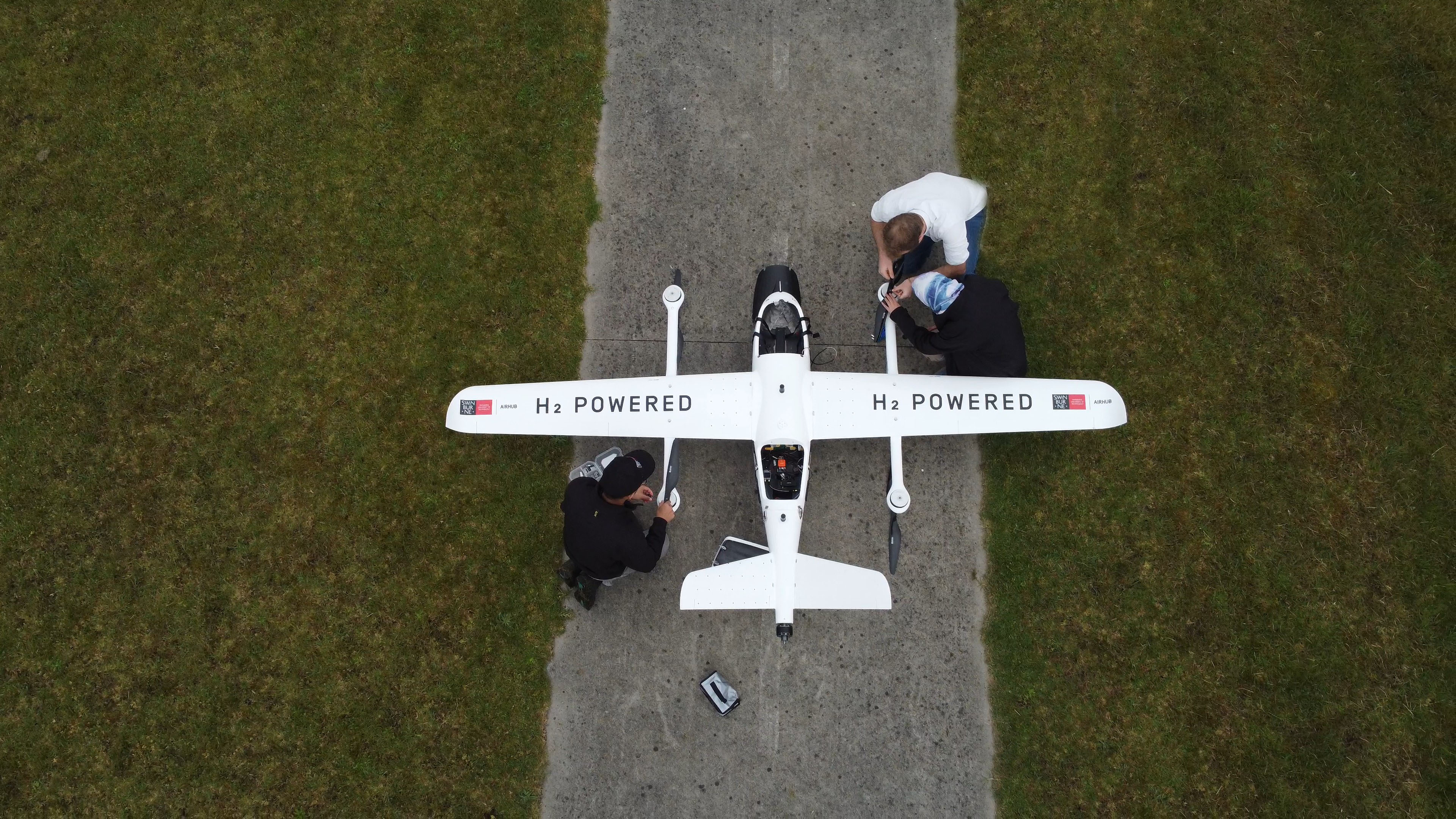Swinburne’s AIR Hub achieves hydrogen flight

The Hydrogen to the Skies team preparing the SHADE drone for its first hydrogen-propelled flight in the Latrobe City Council.
In summary
- Swinburne’s AIR Hub has successfully completed the first flight of an Australian-developed hydrogen fuel cell electric powered VTOL drone.
- The AIR Hub’s innovative SHADE drone is being developed as part of the Hydrogen to the Skies project.
- Hydrogen-propelled uncrewed aircrafts have the potential for significant positive impact on Australia’s supply chain ecosystem, drastically improving access to remote areas of the country.
Swinburne University of Technology’s Aerostructures Innovation Research Hub (AIR Hub) has successfully completed the first flight of an Australian-developed hydrogen fuel cell electric powered VTOL drone. The flight test was achieved using AIR Hub’s innovative Small Hydrogen Aircraft Development & Evolution (SHADE) drone.
This flight marks a significant milestone in Australia’s advanced air mobility (AAM) journey as the first electric vertical take-off and landing (eVTOL), hydrogen-powered uncrewed aerial system (UAS) flight. The successful flight is the result of collaboration with industry partners, researchers and businesses across the aviation and hydrogen industries, including Swinburne’s Victorian Hydrogen Hub (VH2).
The SHADE drone was developed through AIR Hub’s Hydrogen to the Skies (H22S) project, funded by the Australian Commonwealth Government’s Emerging Aviation Technology Partnerships program. The aim of this project is to design and integrate a new hydrogen propulsion system into a large-scale drone to help spearhead the commercial development of clean, zero emissions uncrewed air systems.
The flight occurring last week in Victoria’s Latrobe City Council was the first of its type in Australia. It demonstrates a leap forward in clean aviation, enabling extended range compared to traditionally battery powered UAS, while reducing the environmental impact through sustainably produced hydrogen. This achievement demonstrates Swinburne’s commitment to developing sustainable aviation technologies.
“The successful hydrogen-powered flight of the SHADE drone represents a significant milestone in not only the H22S project, but also the development of net zero aerospace in Australia,” says Dr Adriano Di Pietro, Director of the AIR Hub.
Australia’s net zero AAM future
The success of a hydrogen-propelled flight of the SHADE drone is a significant milestone in the first phase of the multi-phase H22S project.
This will position Australian aerospace and aviation companies to scale up hydrogen use in aviation, with a view to utilise hydrogen propulsion progressively from UAS all the way to passenger and freight air vehicles.
Research being completed by the AIR Hub also speaks to the potential to convert existing internal combustion powered aircraft into emission-free flight.
Hydrogen propulsion will allow longer range regional and remote-area flights than is achievable by battery-powered air vehicles, which are being developed for short-range urban operations. Projects like the H22S project will have significant positive impact on Australia’s supply chain ecosystem, with uncrewed, hydrogen-powered aircraft having the potential to deliver products, including life-saving medications, to some of Australia’s most remote environments.
“Swinburne’s AIR Hub is dedicated to cementing Australia as a key player in the global effort towards the decarbonisation of the aviation and aerospace industry, and we believe that utilising hydrogen power is key to this journey," says Dr Di Pietro.
-
Media Enquiries
Related articles
-

- Technology
Swinburne-led network to guide AI use in youth services
Swinburne’s Dr Joel McGregor, Dr Linus Tan and Dr Caleb Lloyd have established the Responsible AI in Youth Sectors Network. The collaborative network aims to guide the fast-growing use of artificial intelligence in youth services across Victoria.
Friday 12 December 2025 -

- Astronomy
- Technology
- Health
- Science
- University
- Sustainability
- Engineering
Swinburne highly cited researchers reach the top in 12 fields
Ten Swinburne academics have been named on the Highly Cited Researchers 2025 list, released by Clarivate
Tuesday 02 December 2025 -

- Technology
- Health
- Science
- University
$1.2m ARC funding to boost national X-ray spectroscopy capability through Swinburne and QUT partnership
Swinburne has secured $1.2 million in the latest Australian Research Council Linkage Infrastructure, Equipment and Facilities scheme round
Tuesday 02 December 2025 -

- Astronomy
- Technology
- Science
- Engineering
Meet Swinburne’s Roo-ver Mission team
Roo-ver will be Australia's first lunar rover, and it’s being designed, built and tested in Australia. Swinburne is playing a key role in the design and construction of Roo-ver, through its involvement in the ELO2 Consortium.
Wednesday 26 November 2025 -

- Technology
- Health
- Science
- University
- Aviation
- Engineering
Swinburne’s Mobile Innovation Lab hits the road
Swinburne’s Mobile Innovation Lab is a cutting-edge mobile facility designed for research, industry collaboration, STEM education, training and outreach.
Thursday 06 November 2025

